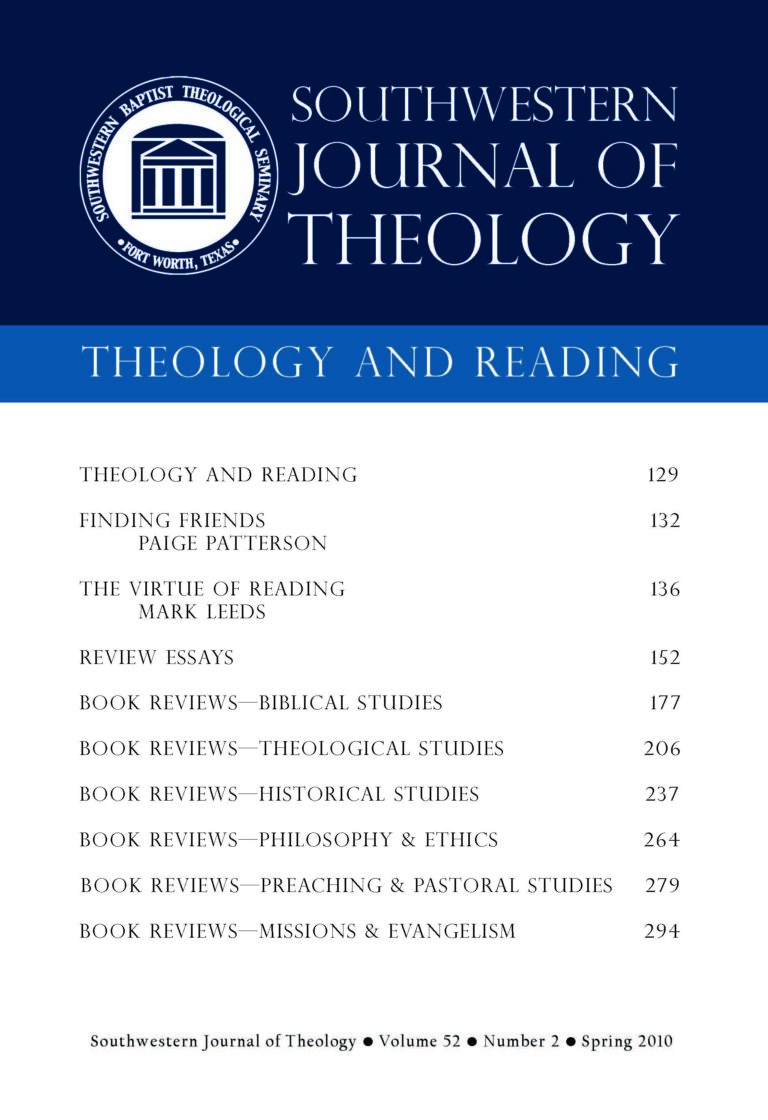
Theology and Reading
Southwestern Journal of Theology
Volume 52, No. 2 – Spring 2010
Managing Editor: Malcolm B. Yarnell III
By David Wells. Grand Rapids: Eerdmans, 2008. 248 pages. Hardcover, $26.00.
David Wells is Distinguished Senior Research Professor at GordonConwell Theological Seminary and a theological conservative. The Courage to Be Protestant is part of Well’s on-going strategy to sound the alarm that in an effort to be more appealing to culture, evangelical churches in America have left their moorings of truth, lost their identity and effectiveness, and, ironically, are adrift at the mercy of the very culture to whom they are trying to appeal. This book is the fifth installment in a series that has spanned 15 years and over 1,300 pages. While his earlier works tended to be laborious reads involving much minutiae, in this fifth book Wells instead captures the essence of his previous four books and writes in a much more concise manner. Readers may remember his previous works in this series: Whatever Happened to Evangelical Theology (1993); God in the Wasteland (1994); Losing Our Virtue (1998); Above All Earthly Powers (2005).
A common notion among critics of Wells’ previous works is that while he admirably demonstrated the troubled times of modern evangelicalism, he stopped far short of providing any solutions. In this book Wells remedies that shortcoming in that while he began with a three chapter summary of his previous arguments regarding the poor health of today’s churches, he devotes the rest of the chapters to systematically providing theological solutions along the five major themes of his previous works: truth, God, self, Christ, and the church.
Chapter one, (especially pages 4–18), provides the clearest explanation of America’s evangelical landscape that this reader has come across. Wells divides today’s churches into three categories and defines them as marketers, or more commonly, seeker sensitive, emerging, and historically evangelical. For those looking for a clear and concise explanation of the differences between these three types of churches, this chapter alone is worth the price of the book.
Throughout his discussions of the aforementioned five major themes of the book, Wells presents and evaluates the positions of the marketer, emerging, and historically evangelical churches as they relate to each theme. Wells makes no attempt to hide his strong loyalty to the position of the historically evangelical churches and his deep-seated concerns about the marketer and emerging trends. Yet, despite his obvious bias, he still manages to come across as the wise old elder toward the end of his time staring into the camp fire at times gone by and sharing with the younger warriors what he has seen; namely, that though dangerous to the historically evangelical church position, the marketer and emerging movements are not a new threat, but merely new forms of the same threats seen many times before.
Wells also makes a compelling case that the threats to the historically evangelical churches, like today’s marketer and emerging movements, have traditionally tended to be spiritualized forms of contemporary, secular cultural trends. He argues that the now all but defunct marketer movement, that recast faith around the individual and was considered cutting edge for its day, was neither creative nor cutting edge as it simply reflected the secular culture’s efforts to recast itself around the individual. In the same fashion, Wells argues the emerging movement’s attempt to recast faith around community is not creative, but a spiritualized form of the current trend in the secular culture.
One issue that has the potential to mute Wells’ voice among residents of the marketer and emerging camps is his regrettable and fairly extensive use of sarcasm toward positions that differ to his own. Regrettable because without the noticeable sarcasm, this book would be a more balanced and compelling voice of reason to the emerging movement regarding the multiple danger points and fallacies of the emerging church culture. As it stands, this otherwise very well written book may be limited to equipping and further entrenching those that already hold to the historically evangelical church position.
Those who have read Wells’ previous works in this series will find this book reads more like a survey of various arguments and positions rather than another lengthy tome; however, his work is still denser than the self help books one finds at their local Christian bookstore. Purchasers of this book should be ones who tend to be more disciplined readers and can synthesize information as they read.
This reader wholeheartedly recommends this work to pastors, church leaders and especially church planters. Wells clearly has the depth of knowledge with regard to doctrine and the breadth of understanding with regard to culture to produce a fascinating and convincing analysis of modern day church trends. Regardless of which camp one identifies with in today’s modern church movements, one can only benefit from considering the tough questions Wells asks of each camp as he evaluates each in light of their theological substance and accuracy. This book could be the most helpful this reader has found with regard to formulating a philosophy and methodology for local church ministry.





